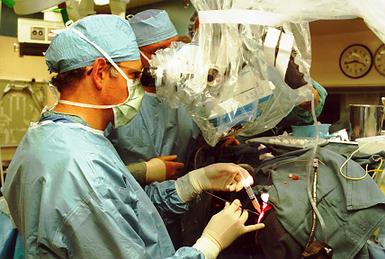Gene therapy applied to brain tumors

Dr. Robert Maciunas (left) recently injected gene therapy cells into the brain of patient Daniel Ellison as part of a study to treat glioblastoma tumors. (Photo by John Howser)
Vanderbilt University Medical Center researchers are adding gene therapy to the arsenal of treatment weapons used to combat highly lethal glioblastoma tumors of the brain.
In a international multi-center clinical trial involving 40 other institutions throughout the world, VUMC investigators are testing a new gene therapy technique that, when combined with standard treatments, may halt the spread of these tumors in the brain.
³This is clearly the cutting edge with respect to gene therapy for brain tumors,² said Dr. Robert J. Maciunas, professor of Neurological Surgery and Biomedical Engineering, and principal investigator of the study at Vanderbilt.
Also integral to the trial are Dr. Paul L. Moots, assistant professor of Neurology, who assesses the patients both pre-operatively and post-operatively to track their progress; and Dr. Anthony J. Cmelak, assistant professor of Radiology and Radiological Sciences, who oversees patient¹s radiation therapy.
Glioblastoma tumors develop rapidly and are among the most aggressive and lethal types of cancerous tumors. The average survival rate for patients is between one and two years, even after undergoing the current standard treatments ‹ surgical removal of the tumor, radiation therapy and chemotherapy.
Glioblastoma tumors are made up of solid tumor cells which are sorrounded by a cloud of smaller, infiltrating tumor cells. These infiltrating tumor cells give rise to other tumors even after the solid tumor cells are removed, making treatment doubly difficult.
³It is as if these tumor cells are peppered throughout the normal matter of the brain. This is the component that usually makes these tumors incurable and the component that this study tries to address,² said Maciunas.
The clinical trial taking place at VUMC involves a fourth treatment component ‹ gene therapy ‹ in addition to the standard treatment methods.
After all visible traces of the solid tumor tissue has been surgically removed, genetically engineered producer cells are injected into the surrounding brain tissue that is infiltrated by the cancer cells. These producer cells contain a retrovirus, in this case a weakened herpes virus, that inserts copies of DNA into both normal and cancerous nearby cells.
While in the brain, the producer cells make a protein called thymidine kinase, which enters the cancer cells as they divide. Since normal brain cells do not divide they do not take up any thymidine kinase.
After 14 days, a harmless drug called ganciclovir is injected at the site of the tumor. The combination of ganciclovir and thymidine kinase makes it impossible for the cancer cells to divide. Without being able to divide, these cancer cells can't multiply and soon die.
³The trials in animal models have been exceedingly promising and have had significant effects on survival and quality of life," said Maciunas. "How that will translate into the realm of human medical care is promising but still not determined."
Daniel Ellison, a 42-year-old furniture maker, was the first patient to undergo the procedure at VUMC. He was discharged from VUMC on Sept. 2 after recovering from the surgery that removed a 3 centimeter tumor from his brain. Ellison is scheduled to get the shot of ganciclovir and begin the standard regimen of chemotherapy and radiation treatment sometime in the next few weeks.
³The surgery went extremely well with Mr. Ellison. We were able to use the techniques of image guided surgery and the benefits of awake craniotomy to maximum benefit,² said Maciunas.
Physicians will be able to determine the effectiveness of the new technique by following Ellison¹s progress.
³This is a good example of the type of cutting-edge transitional clinical care that can happen in the setting of the Vanderbilt Cancer Center supported by the National Institutes of Health,² said Maciunas.
³It is a testimony to the effectiveness of Dr. Harold L. Moses, Benjamin F. Byrd Jr. Professor and chair of Cell Biology and director of the Cancer Center, and the many people working with him that we have been able to bring this trial to VUMC. Dr. George S. Allen, William F. Meacham Professor and chair of Neurological Surgery, has also been instrumental in bringing about an environment where high technology can be used for neurosurgery,² said Maciunas.













